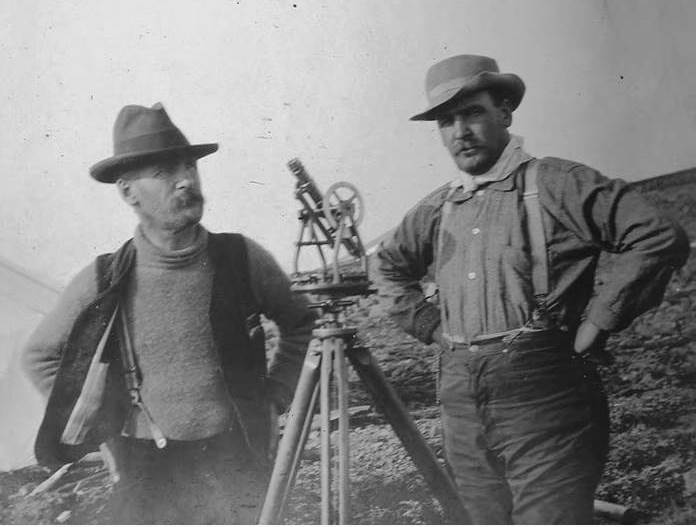
(University of Washington Library, Special Collections, Yukon Territory Album Collection, #AWC7713)
There is a row of graves in the Masonic section of the Hillside Cemetery in Dawson City that is arranged chronologically by the date of death. Near the middle of the row, a grave that had no marker for many years, if ever, has a new headstone for the person buried there. This is the resting place of Henry Godkin Dickson, who died on April 3, 1941.
‘Harry’ Dickson, as he was called, was a pioneer land surveyor in the Yukon and the most prolific when the era and conditions he worked in are taken into account. He committed almost 40 years of his career to the Yukon, and for much of that time he was the Territory’s only surveyor. He worked together with his younger brother Thomas Albert Dickson for most or all of those years.
Harry did much of his work in relatively remote areas and often in adverse terrain and weather conditions, using far less sophisticated equipment than today. For much of his career, before automobiles were in common use, he conducted his work by horseback, horses and wagons, riverboats, and foot.
People in the land surveying profession work in the background and are not generally celebrated, but they perform a vital service in our society. Harry Dickson’s dedication to the Yukon and his place in its history are worthy of recognition.
The Dicksons’ Early Years, 1864-1898
Harry Dickson was born into a large family in Petawawa, Ontario on March 29, 1864. By 1870 the family had moved to Massachusetts, where the father was working on a railroad. In 1873 Harry’s brother Thomas was born in the United States, but the family was back in Canada by 1879 and living near Winnipeg, Manitoba.
In 1888, while living north of Winnipeg in the town of Selkirk, Harry was commissioned as a Provincial Land Surveyor for Manitoba. The following March of 1889, he passed his examination to become a Dominion Land Surveyor (DLS), now called a Canada Lands Surveyor, and his commission number was 221.
In 1890, Harry Dickson was one of 20 surveyors authorized to conduct land surveys in Manitoba. That year he joined with one of the others, a man named James Brownlee, in a partnership in Brandon, Manitoba. The partnership lasted only a few years, but Dickson was to have an ongoing relationship with Brownlee into the Yukon.

(The Winnipeg Tribune, 28 July 1890)
By 1893 Harry was working for the City of Brandon as city engineer, and in 1894 put his survey drafting skills to work in producing a large map of the city. That same year, his brother Thomas passed his examination to become a Manitoba Provincial Land Surveyor. Thomas was also noted as a civil engineer, and he may have focussed more on that when he went to the Yukon. He was to play an integral part in Harry’s surveying work in the Yukon for the rest of his life.
In early 1898, Harry and Thomas Dickson headed for the Klondike to join the gold rush. Similar to many Yukoners’ stories, Harry only planned to be there for two years.
The Year in Atlin, 1899-1900
No information has been found about the Dicksons’ trip west and north, but on March 17, 1899, Harry arrived in Atlin, B.C. and began working for his old partner James Brownlee, who had come to the Yukon in 1897 and then moved on to Atlin. It is not known if Harry ended up in Atlin at Brownlee’s invitation or if it was coincidental. Perhaps en route to Dawson Harry was diverted to Atlin, as were many other people, when it became the newest gold rush hotspot in the late summer of 1898. If it had been Harry’s original intention to go to Dawson, he was not to make it there for many more years.
While in Atlin, Dickson surveyed the John Irving Tramway Co.’s line for the 2¼-mile railway that was being built to provide a transportation connection between Atlin Lake and Tagish Lake. He also did some survey work on the White Pass & Yukon Route railway line.
In October 1899, while still based in Atlin, Dickson carried out the first survey of the newly-developing townsite of Whitehorse, which had just had its name changed from Closeleigh. This survey laid out eighteen 40-acre lots and two smaller ones in preparation for later subdivision. These lots encompassed the area between the river on the east and the tops of the clay cliffs on the west, and from what is now Hawkins Street on the south to the north end of the Marwell industrial area.
Dickson also surveyed the White Pass & Yukon Route railway right-of-way and a 97-acre railway maintenance yard at the south end of Whitehorse. These were within the area from Hawkins Street south to the river where the sternwheeler Klondike and Robert Service Way now are located.
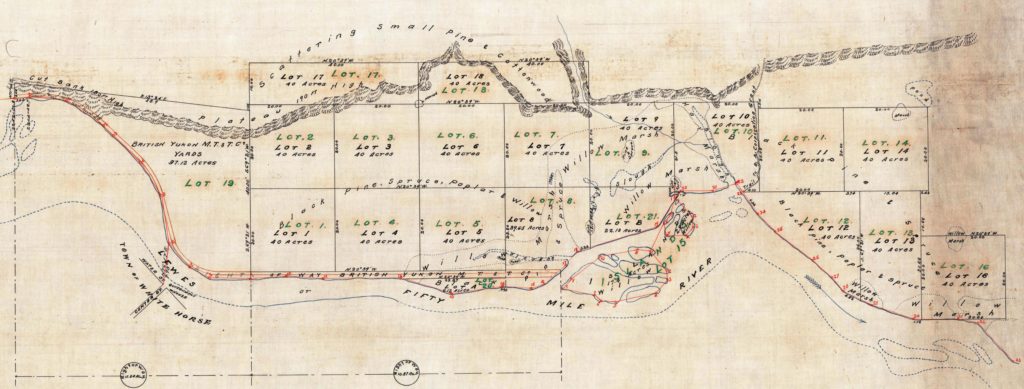
(Canada Lands Survey Records, Plan #8406)
The Whitehorse Years, 1900-1920
In June 1900, after he had completed his work on the Atlin-Tagish railway, Harry Dickson relocated to Whitehorse, where he established a survey business and residence on Main Street. The activities and whereabouts of his brother Thomas after he arrived in the north are not certain, but in 1901 he was living with Harry in Whitehorse and listed as a student at age 28. Harry’s business letterhead and newspaper advertisements in the early 1900s included Civil Engineer along with Dominion Land Surveyor, with the engineering component likely referring to Thomas.

(Whitehorse Weekly Star, 4 August 1911)
Like people of many occupations, land surveyors had come to the Yukon with the Klondike gold rush. In 1901 there were twelve of them in the Yukon, but Harry Dickson was the only one resident in Whitehorse. All the rest were based in Dawson and one other was carrying out the survey of the Yukon-British Columbia boundary. The Dawson surveyors were engaged in surveys of mining claims, roads and townsites. This left Harry to take care of all the southern Yukon surveys, including the various types of lots, homesteads, mining claims, roads, placer creek baselines and reference traverses. He had survey work every year except 1919 and remained the only Whitehorse-based surveyor until he relocated to Dawson in 1920.
The Yukon’s mining activity began to decline in the early 1900s, as did the population, and the number of land surveyors naturally decreased as well. By 1905, there were eight, four by 1910, and by 1918 Harry Dickson was the only one remaining after the departure of A.H. Hawkins, whose job as Director of Surveys for the Yukon was terminated. From 1917 until the end of his career in 1938, Dickson was the only surveyor based in the Yukon.
Beginning in 1903 and over the next 20 years, a number of surveys called ‘reference traverses’ were conducted in the Yukon to establish ‘control’, as it’s referred to, in areas that had no existing survey coverage. These surveys were undertaken in relatively remote areas and would have involved considerable planning and logistics. Harry and Thomas Dickson carried out the first of these unique traverses and a number more.

(Canada Lands Survey Records, Plan #55394)
In early July 1903, gold discoveries in the Kloo Lake area northwest of Haines Junction created a stampede of prospectors into that area. This affected Harry Dickson’s work, as on July 13 he wrote a letter to the Director of Surveys in Dawson and said that due to the “reputed placer strike west of here”, he was having a hard time getting employees for survey work.
The next year Dickson was recruited to accompany Territorial Engineer William Thibaudeau to the Kluane region to begin planning a route for a new road to access the gold creeks. Dickson would later survey the route that was laid out ( a link to related articles on the Kluane Wagon Road can be found at the end of this article ). This was the beginning of an association he was to have with the Kluane area, including doing all the surveying work there, until the end of his career 34 years later.
Harry Dickson’s surveying and drafting skills assisted him in making maps as well. In 1904 he produced two maps, one of the Whitehorse and nearby copper belt area and the other of the new ‘Alsek, Kaskawulsh and Kluane’ gold-mining region. These maps were apparently well received and in common use for a number of years afterwards.

(Yukon Archives, Map H-430)
In June 1904, Dickson surveyed a 43-acre mining claim in the Whitehorse copper belt that had been staked by two men in 1899. The ‘Spring Creek’ claim, as it was named, was located about 6 km. southwest of Whitehorse city center, near the upper end of McIntyre Creek. In 1905 Harry and his brother Thomas purchased the claim, and in 1915 did over $9,500 worth of work on it (over $82,000 in 2019 dollars), perhaps for assessment purposes and with financial backing.
Both brothers retained ownership of their portions of the Spring Creek claim until their deaths. When Harry died in 1941, his three-fifths ownership became part of his estate and it was deemed to have no value. The Spring Creek claim, described as Lot 162, Quad 105D/11, still stands as a legally surveyed property.
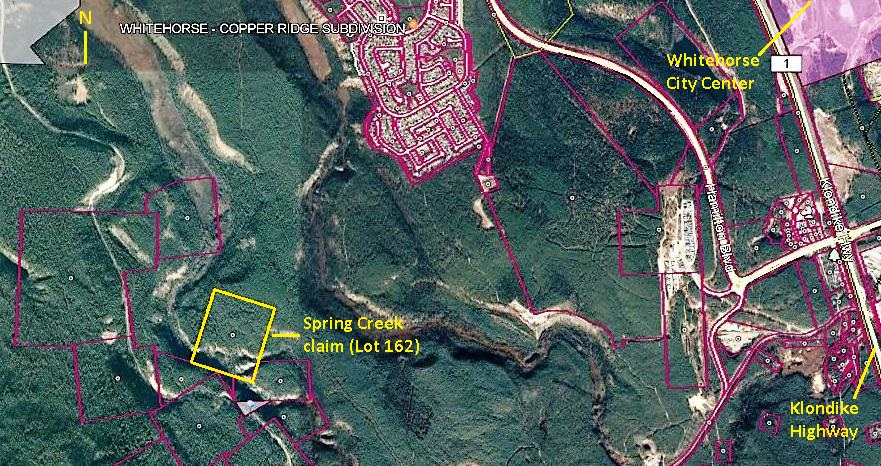
(Google Earth)
In April 1908, at age 44, Harry Dickson’s personal life took a turn when he married a 38-year old American woman named Margaret Haughton in Whitehorse. This didn’t last long, however, due to Margaret’s poor health. In November of that year she went to Victoria, intending to spend several months there in hopes of getting well. It was not to be, and she ended up passing away in early May 1909 in St. Louis, Missouri, where she had lived previously. Harry received a telegram notifying him of her death.
In 1910, with the Yukon’s economy and population declining, there were only four surveyors remaining in the Yukon, three in Dawson and Harry Dickson in Whitehorse. That year, Frederick Congdon, the Yukon’s Member of Parliament, wrote to the Surveyor General in Ottawa about “… the desirability … to keep good surveyors in the country…”. He said that “… although adverse conditions have made development slow… I know of no better or more legitimate mode of assistance than completion of useful surveys”. His letter resulted in the initiation of more reference traverse surveys beginning in the following year and for a few years thereafter, most of which employed the Dickson brothers.
Harry Dickson appeared to be a relatively active member of the Association of Dominion Land Surveyors, based in Ottawa. In 1913 he was elected as the Association’s vice-president for the Yukon and Northwest Territories, a post he had not even put his name in for. The following year he wrote a paper about the standardization of qualifications of Dominion Land Surveyors and the various Provincial Land Surveyors.
There are three records of Harry travelling out of the Yukon, all during his Whitehorse years. Two of them, in 1911 and 1915, were to visit his parents before they passed away. In the case of his mother, he did not make it in time to see her before she died in Sault Ste. Marie, Michigan, but was able to be at her funeral.
Surveys during Whitehorse years, 1900-1920
Harry and Thomas Dickson carried out many survey projects during their time in Whitehorse, and the following examples are of their larger or notable ones. They surveyed a large number of mining claims, most of them being on the order of 40 to 50 acres, and many located on or near the tops of mountains. There were other more minor projects in addition to these.
1900
- Mining claims near Whitehorse Copper mine site totalling about 260 acres
1901
- Coal lands south of Fish Lake – nine claims totalling 1,440 acres
- Whitehorse townsite – subdivision of earlier surveyed large lots to create 548 town lots
1902
- Survey and production of map linking town of Whitehorse to mining claims and wagon roads in the Whitehorse Copper Belt
1903
- Whitehorse – extension of Second Avenue to north end of present Shipyards Park
- Public roads to Grafter and Copper King copper claims
- Whitehorse Reference Traverse
1904
- Addition to Whitehorse townsite – creation of 156 town lots and one 10-acre lot within the 1899 lots
- Bullion Creek baseline for placer claims
- Chambers 100-acre and 26-acre lots at Champagne
1905
- Carcross Indian Reserve #6
- Conrad townsite subdivision
- Reference Traverse from British Columbia boundary to Carcross
1906
- Two additions to Conrad townsite
- Burwash Creek baseline for placer claims
1907
- Lots, mostly in Whitehorse area
1908
- Mining claims in Montana Mountain (Carcross), Whitehorse-Fish Lake, and Alligator Lake areas
- Wheaton River Reference Traverse (West Arm Bennett Lake to Watson River)
1909
- Mining claims in Montana Mountain (Carcross), Whitehorse-Fish Lake, and Alligator Lake areas
- Wheaton River to Whitehorse Reference Traverse connection (Watson River to Golden Horn Mtn.)
1910
- Mining claims south, west and north of Whitehorse and in Montana Mountain and Alligator Lake areas
- Mining claims south of Carmacks (Dickson’s first trip north of Whitehorse)
- Carmacks Reference Traverse, part 1 (Carmacks to Kirkland Creek)
1911
- Mining claims in Whitehorse west area
- Carmacks Reference Traverse, part 2 (Kirkland Creek to Mt. Decoeli/Jarvis River)
1912
- Mining claims in Wheaton River area
- Aishihik Reference Traverse , part 1 (Nansen Creek to north end Aishihik Lake)
1913
- Kluane Wagon Road, part 1 (Kluane Lake to Jarvis River)
- Fourth of July Creek baseline for placer claims
- Mining claims in White River, Beaver Creek, Whitehorse west, Montana Mountain and Wheaton River areas
- Reference Traverse Kluane Lake to Bullion Creek baseline connection
- Ibex River Reference Traverse (Whitehorse to Takhini/Ibex River area)
- Aishihik Reference Traverse, part 2 (north end Aishihik Lake to south end)
1914
- Six Mile Indian Reserve #5
- Mining claims west of Whitehorse and in Wheaton River area
- Sixty Mile River Reference Traverse (likely Dickson’s first trip to Dawson area)
- Sixty Mile River baseline for placer claims
1915
- Kluane Wagon Road, part 2 (Overland Trail to Jarvis River)
- Traverse of Grazing Lands in Dezadeash Valley
1916
- Mining claims south and west of Whitehorse
- Whitehorse Indian Reserve #5
1917
- Mining claims in Whitehorse west and Montana Mountain area
- Homesteads in Tagish area
1918
- Lots at McRae and Whitehorse
- Whitehorse Indian Reserve #5
1919
- none
1920
- Chambers Homestead on Mendenhall River
The above list of the Dicksons’ surveys provides an indication of the scope and scale of the projects they undertook. In addition to the physical work, significant time would have been involved in planning the survey, hiring personnel, and logistics planning for transportation, accommodation, provisions, supplies and equipment. After the physical survey was completed, there was more time spent in drafting and submitting the survey plans and tending to administrative matters such as correspondence, payroll and bookkeeping.
In 1919 no surveys of note were done in the Yukon, or at least none that produced survey plans. This was evidently due to a lack of survey work in the only part of the Yukon that had a resident surveyor. That fall Harry Dickson wrote to George Mackenzie, the senior federal bureaucrat in Dawson, basically pleading for work. He stated that “… it is an absolute necessity to have something to do, in order to live …”. He identified two homesteads along the Kluane Wagon Road that were ready for surveying, and the following spring he was authorized to survey the Chambers homestead on the Mendenhall River.
This homestead survey would be the Dickson brothers’ last work in the southern Yukon before leaving Whitehorse in 1920. The work situation undoubtedly prompted them to make the decision to move to Dawson, and for Harry it was the beginning of the next chapter of his career at the age of 56.
The Dawson Years, 1920-1938
A review of the major surveys conducted by Harry Dickson after he relocated to Dawson suggests that he should have moved to Mayo instead. His first survey was an addition to the Mayo townsite and, as it turned out, much of the work he and Thomas did over the next 18 years was in the Mayo area. A significant amount of their activity focussed on the survey of mining claims in the silver-producing area around Keno City.

(Canada Lands Survey Records #31348)
Newspaper articles indicate that Thomas Dickson retained a stronger work connection to the Keno area than did Harry, who may have conducted more of the work in the Dawson area. Unlike Harry’s previous business advertisement in the Whitehorse newspaper, the one in the Dawson newspaper contained both their names.

(Dawson Daily News, 27 September 1922)
It appears the Dickson brothers were quite busy in the first several years after relocating to Dawson, mainly due to the level of activity in the Keno area in the 1920s. However, after 1930 the survey work quickly tapered off, to the point that in 1932 there were no surveys done, at least none that resulted in registered plans.
In the summer of 1931 the Yukon Government appointed 67-year old Harry as Survey Engineer at a salary of $1,200 per year as an incentive for the Territory’s only surveyor to stay. Harry had normally been getting about $3,000 worth of government work each year, so he regarded the $1,200 as a retainer, and any survey work would be in addition. Harry stayed in the Yukon, so the government appointment appears to have achieved the desired result.
Being the only Yukon surveyor, Harry along with his brother occasionally made trips south from Dawson, presumably most or all by riverboat, to do survey work. They surveyed lots in Whitehorse, Tagish and Carmacks, homesteads at Robinson and Burwash Landing, aviation fields at Carmacks, Fort Selkirk, Carcross and Whitehorse, and the Carmacks Indian Reserve #11.
Surveys during Dawson years, 1920-1938
The following are the major or notable survey projects undertaken by Harry and Thomas Dickson during their Dawson years.
1920
- Addition to Mayo townsite
- Mining claims in Keno area and northeast of Dawson City
1921
- Mining claims in Keno area
- Mining claims in Williams Creek area (north of Carmacks)
1922
- Mining claims in Keno and Mayo areas
- Keno townsite
- Traverse of Government Road Keno to Ladue Claim
- Mining claims in Whitehorse, Alligator Lake and Wheaton River areas
1923
- Mining claims in Keno area
- Keno Hill – Mt. Rambler – Mt. Cameron Reference Traverse
1924
- Mining claims in Keno area
- Mayo – Steep Creek Reference Traverse
- Lots in Carmacks
1925
- Mining claims in Keno area
- Carmacks Indian Reserve #11
- Lots near Williams Creek (north of Carmacks)
1926
- Mining claims in Keno and upper Beaver River areas
- Huffman (Mayo area) and Leroux (Dawson area) Homesteads
1927
- Mining claims in Keno and Beaver River areas and Yukon River north of Dawson
- Mayo – Keno Road
- Detraz Homestead at Coffee Creek
1928
- Mining claims in Keno area
- Mayo – Dawson Road, part 1
- Mining claims in Montana Mountain and Wheaton River areas
- McConnell Homestead at Robinson (south of Whitehorse)
- Lots at Tagish
1929
- Mining claims in Keno area
- Lefebvre’s Ranch on Stewart River
- Mayo-Dawson Road, part 2
1930
- Mining claims in Keno area
- Mayo-Dawson Road, part 3
1931
- Mining claims in Keno and Beaver River areas
1932
- none
1933
- Lot northeast of Dawson
1934
- Indian River baseline for placer claims, part 1
1935
- Jacquot Homestead at Burwash Landing
- Whitehorse Aviation Reserve
1936
- Indian River baseline for placer claims, part 2
1937
- Mining claims in Bonanza Creek area
- Mayo Airport
- Fort Selkirk Airport
- Carmacks Airport
- Carcross aviation field
1938
- Mining claims in Keno area
Harry Dickson’s Record
Harry Dickson carried out his last land surveys in 1938 at the age of 74. Over the 39 years of his career in the Yukon, the list of surveys that have his name attached to them is extensive, far greater than anyone else of that era.
In addition to the impressive quantity of Dickson’s work, the quality of it appears to be well-regarded, as surveyors since that time have used and followed upon his work. Brian Thompson, a surveyor with decades of experience in the Yukon, says that “[Dickson’s] work accurately marks the boundaries of many land interests that still exist today, and allows modern-day surveyors to build from them and establish the boundaries of new land interests”.
Thompson and Gabe Aucoin, another long-time Yukon surveyor, offered their perspectives that Harry Dickson generally did good work. His measurements, particularly in mountainous areas where measuring distances horizontally is more challenging, were of good quality considering the equipment he had to use. He also paid attention to leaving good physical evidence of his surveys, an important component of surveying work. Brian Thompson added that “[Dickson’s] survey of the Whitehorse townsite group lots is near perfect”, referring to the first survey of Whitehorse in 1899.
Surveyors leave behind varying accounts of the details involved in their work, and some have left journals of their daily activities. Field books sometimes include information about the members of the survey crew, weather conditions, vegetation, and features they encounter such as cabins, graves and trails. Harry Dickson appears to have been a minimalist in such documentation, which is unfortunate given the breadth of his survey work and, from a Yukon history perspective, the time period it took place in.
This lack of recording may be reflective of his character as suggested by his few interviews for newspaper articles, where he was very matter-of-fact about his work. Here is an example:
Leaving Whitehorse, we proceeded by team to Champagne Landing, thence by packhorses, by way of the Dalton Trail via Hutchi village, to the copper locations near Aishihik Lake. Leaving a cache at this point, we travelled in a northeasterly direction and picked up the end of the [survey] line run by us last season [from Carmacks]. Our mission was to extend this line in a southwesterly direction, crossing the Aishihik River where it leaves the lake of that name to the copper locations on the Jarvis River, south of the Kluane trail. This was successfully completed”.
“Successfully completed” was Harry Dickson’s understated summation of a two-month expedition to travel and find, from the opposite direction, the spot in the bush where they left off surveying the previous fall, and then resume the survey for another 105 kilometers. Most of this was through remote country that would have been little known to him and his crew and likely offered a number of challenges for them to overcome.
Harry Dickson’s Yukon survey work is still contributing in various ways, almost 80 years after his death. Pieces of information contained in his survey plans and field books tell of Yukon history. These along with the survey evidence that still stands in places on the Yukon landscape assists modern-day surveyors in their work and history researchers in pursuing their interests.

(Roberta Allison photo, 2016)
Thomas Dickson’s Contribution
This article is primarily about Harry Dickson and his contributions to the Yukon land survey fabric and Yukon history, but it must necessarily include his brother Thomas’s involvement as well. While Harry’s surveying career is relatively well documented by the survey plans and related field books that he produced, Thomas’s work is somewhat difficult to pin down.
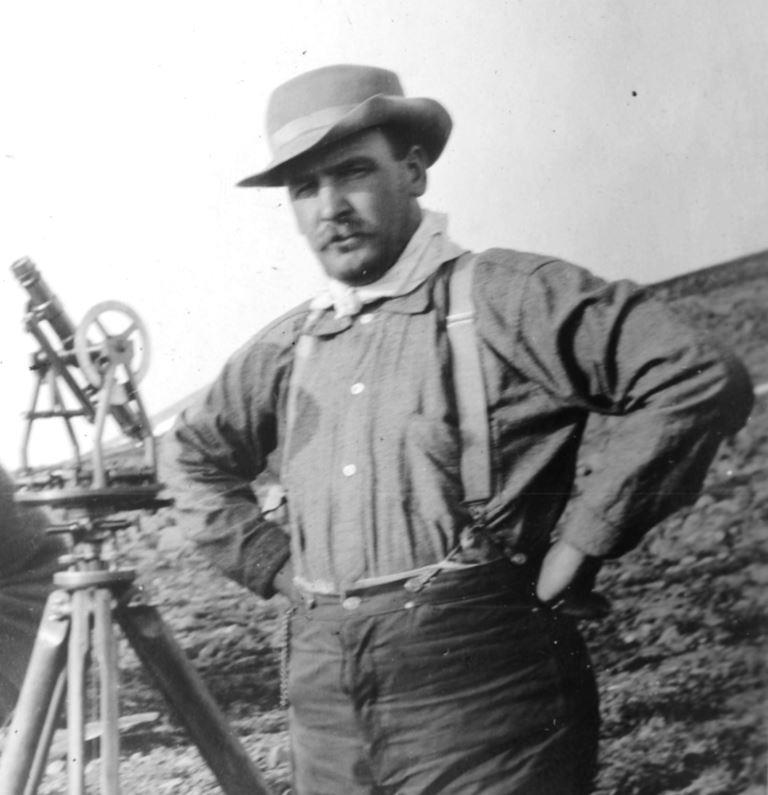
(University of Washington Library, Special Collections, Yukon Territory Album Collection, #UW36282)
It is clear from survey records, newspaper articles and Thomas’s estate file that he assisted his brother in a significant way. Thomas was a commissioned Provincial Land Surveyor in Manitoba, so obviously had the ability to conduct land surveys. A few Yukon newspaper articles also referred to him as a Dominion Land Surveyor, which was required for surveying in the Yukon, but either this was an error or he never used his designation in the Yukon. He appears to have done a lot of the ground work, so perhaps left the administrative matters, including signing off on survey plans, to his brother.
The survey plans and field books included an oath that the surveyor must swear before somebody that is authorized to administer it. When I started studying Harry Dickson’s survey plans I noticed that some were sworn before a T.A. Dickson, who I assumed to be Thomas Alexander Dickson. He was a well-known former Northwest Mounted Police member and it seemed understandable that he could have been appointed to administer such oaths. It was some time before I realized that Harry Dickson had a brother in the Yukon named Thomas Albert Dickson and that it was he who was taking his brother’s oaths, such as in the example below.

(Canada Lands Survey Records #54140)
Thomas Dickson evidently did some work independent of his brother that employed his engineering background. For example, in the fall of 1905 he was in charge of a crew of ten men doing river channel work at Hell’s Gate on the Yukon River. This involved driving piles and constructing dams to direct water into the main riverboat channel.
Thomas appears to have had health difficulties off and on, including a “serious operation” in the late fall of 1927 in Vancouver. He again left the Yukon for medical treatment in the spring of 1939, returning to Whitehorse on April 15. He took a room at the Whitehorse Inn, where at some point during the night he passed away. The Whitehorse Daily Star reported that he died in his sleep, but his estate file makes it clear that his death was an unpleasant one.
Thomas had made a will in 1928, bequeathing to a Miss Katherine McNab his interest in a mining claim near Whitehorse, some shares in a mining company, and his watch and jewelry. The remainder of his estate, which did not amount to much, went to his brother Harry, who was also the executor of the will.
The Katherine McNab named in Thomas Dickson’s will was a teacher and had been in Dawson for a time. She responded to his death by letter from Penticton, B.C., expressing her shock at the news. She also said that Thomas “… was a very loyal friend with potential for good, but life seemed to trap him”. She mentioned a long period of depression and that she had felt impotent to help. She also said she was unaware of his will and that she could not possibly accept anything of value while Thomas’s brother Harry was alive.
Thomas Dickson’s funeral was held on April 19 at the Masonic Temple in Whitehorse, followed by burial in the Masons section of the Pioneer Cemetery. He was 66 years old.
Harry Dickson’s Final Years
There is no record of Harry Dickson having done any survey-related work after 1938. His own physical limitations and the death of his brother in 1939 perhaps made the decision for him. Thomas’s death also may have prompted Harry to get his own affairs in order, as a few months afterwards he made a list of his property and valuables and where they were located.
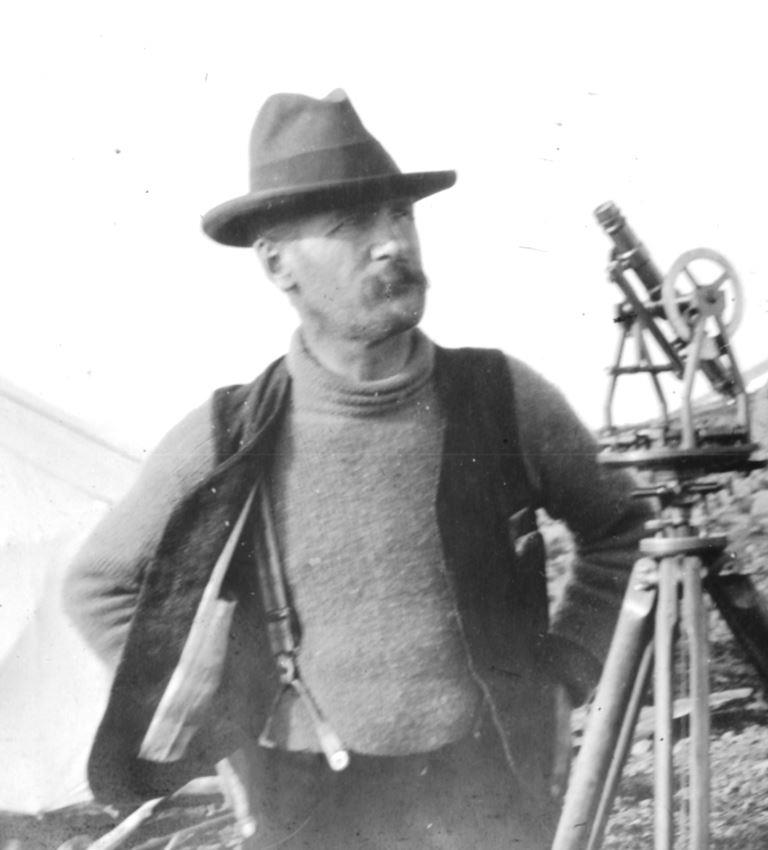
(University of Washington Library, Special Collections, Yukon Territory Album Collection, #UW36282)
Harry remained in Dawson, living in the house there that he had inherited from Thomas. In late March 1941 he entered the St. Mary’s Hospital in Dawson for medical treatment and then returned home, but not for long. He passed away on April 3, 1941 at the age of 77.
In his will Dickson left everything to his brother Arthur Dickson, who lived in Milwaukee, Wisconsin. This included his interest in the Spring Creek mining claim he had surveyed in 1904 and co-owned with Thomas since 1905. After the estate was settled, Arthur received $561.32. Harry Dickson never got rich doing what he did in the Yukon, but his contributions are a more appropriate measure of his life here.
Harry Dickson’s funeral was held on April 8 in the Anglican Church in Dawson. He had become a member of the Masons in 1893 in Brandon, Manitoba, and after the funeral his body was escorted by the Masons to the Hillside Cemetery, where it was buried in the Masonic section.
It appears that Harry Dickson’s grave never had a headstone, and until recently was marked only by a piece of blue rebar with a bronze-colored cross on top. Fortunately, the burials over the years in the Masonic cemetery have been made in chronological order along the row, enabling his grave location to be confirmed by the headstones on either side of it.

(Gord Allison photo)
The Masonic Lodge #45 in Dawson was made aware of the person buried in the unmarked grave and his contributions to the Yukon, and they agreed that the situation should be rectified. The Masons took the initiative and expense to have a headstone made for him, and in September 2023, more than 80 years after Harry Dickson’s death, members placed it at his grave . Thanks to their efforts, Henry Godkin Dickson’s final resting place is now properly marked and acknowledges his life as ‘Yukon Land Surveyor’.
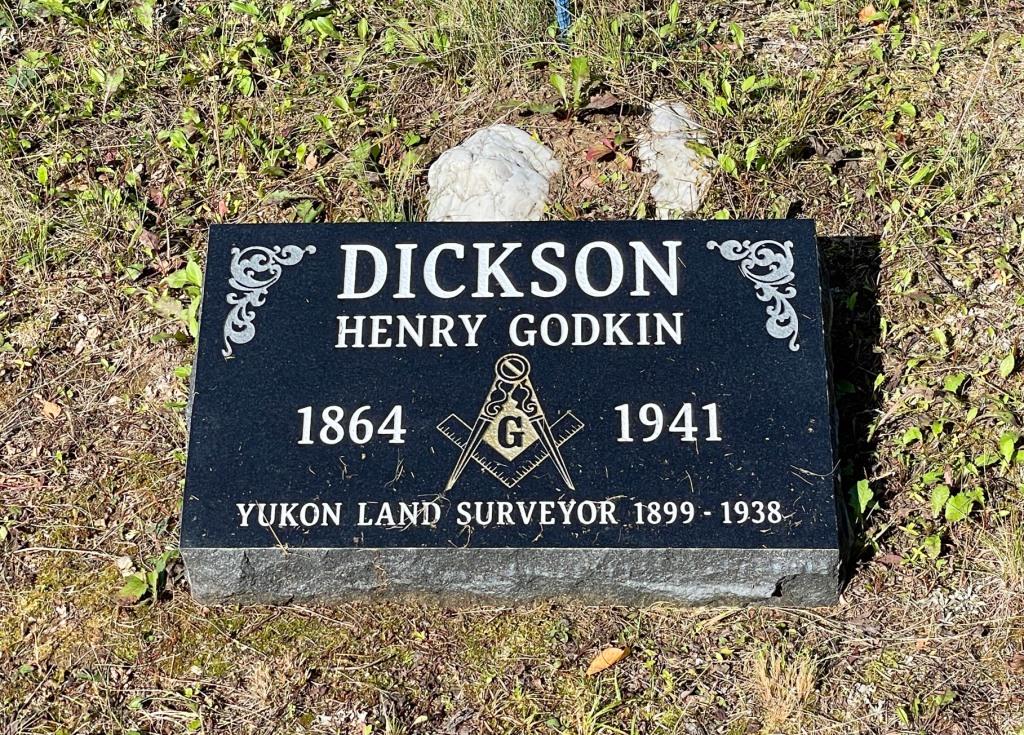
(Photo by Ed Whitehouse and provided courtesy of Tom Mickey)
Link to related articles: Kluane Wagon Road
Updated January 27, 2020
Updated October 3, 2023